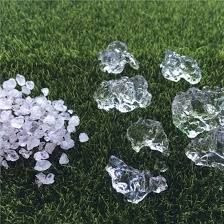A hydrogel is a network of crosslinked hydrophilic polymer chains. In the medical field, hydrogels are utilized for absorbing body fluids and exchanging substances with the external environment. They are also effective as carriers in wound treatment. Similarly, hydrogels find applications in agriculture, offering advantages such as reduced irrigation needs and prolonged container shelf life.
Hydrogels can be categorized into two main groups based on their physicochemical properties. The first group comprises reversible hydrogels, where polymer chains are linked through electrostatic forces, hydrogen bonds, and hydrophobic interactions. These hydrogels are characterized by instability and can be transformed into a polymer mixture, such as gelatin and agar, through heating. The second group consists of chemically stable hydrogels with polymer chains linked by stable covalent bonds, including starch and vinyl monomers like acrylic acid, acrylamide, acrylonitrile, and polyvinyl alcohol.

In agriculture, a commonly used hydrogel type is potassium polyacrylate or sodium polyacrylate. Hydrogels show promise in agriculture due to their easy decomposition in soil and renewable nature compared to other commercial superabsorbent polymers. Studies have demonstrated the benefits of hydrogels as soil amendments or for seed-coating, improving water and fertilizer retention, soil aeration, reducing evapotranspiration, enhancing seedling emergence, and sustaining water availability for plants.
Hydrogel Applications Hydrogels offer numerous benefits in agriculture by addressing challenges such as low water retention, high transpiration rates, soil moisture leaching, and phytopathogen attacks. Their applications include improving soil quality, water conservation, resistance to drought stress, reduced irrigation frequency and water consumption, lower seedling mortality, and minimized fertilizer and pesticide usage. Hydrogels find diverse applications across agriculture, forestry, industrial planting, municipal gardening, drought management, and water conservation, effectively reducing soil erosion and leaching of chemicals into groundwater.
A recent study by Kalhapure et al. focused on a new absorbent polymer called “Pusa Hydrogel,” developed by the Indian Agricultural Research Institute. This hydrogel, based on potassium polyacrylate, exhibited high absorbency, reduced leaching of herbicides and fertilizers, improved soil properties, and enhanced plant growth without adverse effects on crops or soil.
Soil Amendment Studies on hydrogel applications in seed-coating and soil amendments highlight their ability to improve water and fertilizer retention, soil aeration, and reduce evapotranspiration rates. Hydrogels can modify soil properties like permeability, density, structure, and texture, significantly increasing water-holding capacity and reducing soil bulk density. However, excessive hydrogel use can saturate soil water content, particularly in arid regions, although it improves leaf water and chlorophyll content.
Reduction of Drought Stress Hydrogels help plants cope with drought stress by maintaining adequate water content, enhancing growth, and increasing yield under unfavorable climatic conditions. They reduce the need for frequent watering, extend plant shelf life, and improve water storage in porous soils, delaying wilting periods and promoting plant survival.
Enhancement of Fertilizer Availability Hydrogels offer a sustainable approach to reduce synthetic fertilizer usage without compromising crop yield or nutrient value. They can be formulated with potassium and nitrogen ions for gradual nutrient release into the soil, promoting plant growth and absorption.
In summary, hydrogels play a crucial role in sustainable agriculture, offering solutions to water conservation, soil improvement, drought stress mitigation, and enhanced plant growth while minimizing environmental impact and resource usage.

